|
 Cortinarius meleagris Cortinarius meleagris
SynonymsRozites meleagris
BiostatusPresent in region - Indigenous. Non endemic
Images (click to enlarge)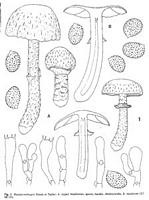 | 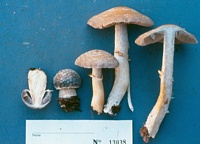
Owner: Karen Hughes | 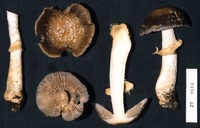
Caption: ZT9684
Owner: E. Horak: © Creative Commons Attribution-Noncommercial 3.0 New Zealand | 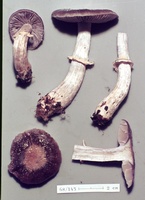
Caption: ZT68-143
Owner: E. Horak: © Creative Commons Attribution-Noncommercial 3.0 New Zealand | 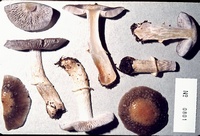
Caption: ZT0801
Owner: E. Horak: © Creative Commons Attribution-Noncommercial 3.0 New Zealand | 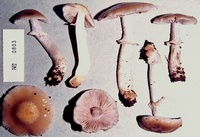
Caption: ZT0803
Owner: E. Horak: © Creative Commons Attribution-Noncommercial 3.0 New Zealand | 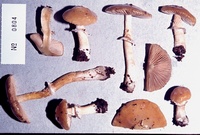
Caption: ZT0804
Owner: E. Horak: © Creative Commons Attribution-Noncommercial 3.0 New Zealand | 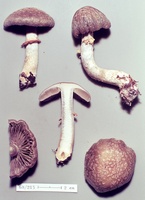
Caption: ZT68-215 , Holotype
Owner: E. Horak: © Creative Commons Attribution-Noncommercial 3.0 New Zealand | 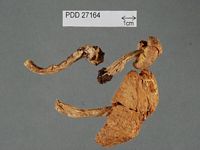
Caption: Dried type specimen
Owner: Herb PDD |
Article: Horak, E.; Taylor, G.M. (1982) [1981]. Fungi Agaricini Novazelandiae. XI. Rozites Karsten. New Zealand Journal of Botany 19(4): 353-360 (http://www.rsnz.org/publish/abstracts.php).
Description: Pileus - 85 mm, hemispheric to convex later becoming expanded or depressed at centre; grey to pale grey-brown with lilac tint, becoming ochraceous with age (especially at disc), densely covered with white to pale yellow-brown, coarse, persistent, fibrillose squamules from veil; glutinous when moist, margin striate in over mature specimens. Lamellae broadly adnate to emarginate (with sub-decurrent teeth), crowded; pale lilac soon changing to pale argillaceous or pale grey-brown, edge concolorous, serrate to sinuate. Stipe 50-120 x 10-20 mm, cylindric, equal or subclavate at base; lilac above, pale brown towards base, densely covered with concolorous to ochraceous fibrillose to scaly squamules from veil, strongly fibrillose; annulus membranous, striate, pale ochre, persistent, occasionally evanescent with age; dry, hollow, single, often in groups. Context lilac in upper portion of stipe and beneath cuticle of pileus, pale brown in base of stipe. Odour and taste not distinctive. Chemical reactions on pileus: KOH - brown, HC1and NH3 - negative. Spore print (ochre) brown with ferruginous tint. Spores 10-12.5 x 7.5-9.5 µm, broadly pip-shaped to amygdaliform, brown, minutely verrucose, mucro absent. Basidia 30-45 x 11-14 µm, 4-spored. Cheilocystidia 15-50 x 6-10 µm, cylindric to subclavate, hyaline, membrane thin-walled, often inconspicuous in mature basidiomes. Cuticle: epicutis composed of cylindric hyphae (8-16 µm diam.), membrane gelatinised; subcutis consisting of globose to polygonal cells (10-40 µm diam.); all membranes encrusted with yellow to yellow-brown (KOH) pigment. Clamp connections numerous.
Habitat: o n soil among litter and moss (including Sphagnum) in Nothofagus forests (Nothofagus fusca (Hook.f.) Oerst., N. menziesii (Hook.f.) Oerst., and N. solandri (Hook.f.) Oerst.). New Zealand.
Notes: Using the pertinent key for the identification of New Zealand's agaricaceous genera (Horak 1971a), Rozites meleagris is likely not to be recognised as a member of Rozites. Contrary to the majority of described taxa in Rozites, this species is characterised by deep lilac lamellae which gradually turn rust-brown. The lilac tint, however, is always recognised in the context of the stipe even in overmature basidiomes. In the field R. meleagris is readily identified by the strongly developed and persistent veil remnants (velum universale) that give the surface of the pileus a characteristic speckled appearance strongly reminiscent of a starling's winter plumage.
|